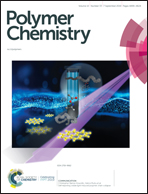Inorganic/organic hybrid magnetic polymers based on POSS and pyridinium FeCl4: the effect of self-assembly
Abstract
Polymer self-assembly was utilized in changing the morphology of polymers in both solution and bulk. Therefore, the physical properties of the polymers were changed for special applications. Herein, we study the effect of self-assembly on the magnetic properties of inorganic/organic hybrid magnetic polymers. In detail, three different molecular weight magnetic polymers based on polyhedral oligomeric silsesquioxane (POSS) and pyridinium FeCl4 (POSS-QP4VP[FeCl4]-3k, POSS-QP4VP[FeCl4]-6k, and POSS-QP4VP[FeCl4]-9k) were designed and synthesized by the post-modification of POSS-QP4VP, which were prepared by RAFT polymerization. The prepared polymers showed paramagnetic properties at 300 K and their magnetic susceptibility increased with the degree of polymerization. In a selective solvent, the polymers self-assembled into spheres with POSS aggregates as the core and QP4VP[FeCl4] as the shell, and the thickness of the shell increased with increasing molecular weight. The magnetic properties were affected by self-assembly and molecular weight. For those with a molecular weight of 3k, the magnetic susceptibility was greatly increased. However for those with molecular weights of 6k and 9k, the magnetic susceptibility was decreased. The magnetic susceptibility was closely related to the surface packing of QP4VP[FeCl4] chains, which were more amorphous at a higher molecular weight.



 Please wait while we load your content...
Please wait while we load your content...